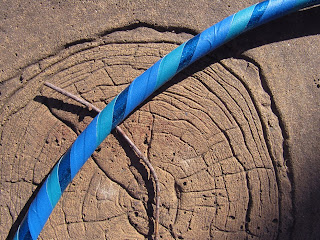This question has been answered before, with Hooposophy doing an incredibly detailed job. Just for the basics, though, I think there are some good cues to look for when thinking about making a change. Often times people struggle when choosing based on a 'feeling' because they have no context! If you only know the hoop you have, how can you weigh the pros and cons? Let's break it down this way and hopefully clear things up:
The Three Hoop Sizes All Hooper's Should (eventually) Have
Heavy Beginner Size, 39"-43" diameter. 3/4" tubing
(if you stand behind the hoop in a vertical position the 'top'
will be taller than your navel in most cases)
(if you stand behind the hoop in a vertical position the 'top'
will be taller than your navel in most cases)
When to get it: immediately
Most likely your first hoop, you want to keep this grippy, heavy beast around for learning new moves, because you can move at a much slower pace. It's also great for when you meet new people who want to try hooping, but would not fare too well with a shiny performance hoop. This is also the most effective size when working with the digestive benefits of hooping.
Verdict: Start with this, and keep it with you for new moves and chill-out sessions.
When to get it:
Get this size when you have mastered your first 3-4 'tricks.' You know, you can waist hoop, do the vortex, booty bump, and single weave. After getting your first couple of moves, the next succession can actually be more challenging with a big, heavy hoop. Think about stir the pot, it is usually one of the earlier moves learned, yet it is hard to bend over far enough to clear a 43" behemoth. Still can't shoulder hoop? Who cares! Getting a lighter hoop will help you experiement with different styles of movement while you make progress. This will most likely be your 'main' hoop for the longest amount of time. If you foray into multi-hooping (which I hope you do) this is the size that you should mimic with your twin.
Verdict: (after about 3 -10 months) When you have a few things under your belt and are ready to explore more transitions and off-the-body moves. Even if you think that your 'go-to' moves, like waist hooping and the vortex, will be more of a challenge than with the beginner hoop.
When to get it:
You are a hooper. You have been one for awhile. You know the basic tricks, and have breaks and reversals down, can leg/chest/shoulder hoop like nobody's business, and people constantly comment on how when you waist hoop you 'barely move!" You've tried multi-hooping and mini's and you are missing something. You are ready to challenge yourself again, to find your own hoop style and you want the hoop that will get you there. It's time to invest in a lightweight, grip-tape free, tiny hoop.
Verdict: (after 1-2 years) You are a well seasoned hooper with a vast array of tricks under your belt and are looking for that polishing finish.
So here is the spiel you will hear every time this question is answered: everyone is different. Maybe you are ready for a pro hoop in 3 months, or 10 years. Maybe you never really get comfortable with anything but your first hoop. These time estimates are guidelines to help you make a decision confidently if you are thinking about making a change.
Find out what works best for you by taking chances. When in doubt - go smaller. Maybe it won't work out great in the beginning, but a small hoop just requires faster movement. Just like with waist hooping at the very beginning the hoop may drop, but keep trying and it will come around.
If you are still nervous, think of it this way, I have never heard someone say, "yeah, i really wish I hadn't gotten that hoop."



No comments:
Post a Comment